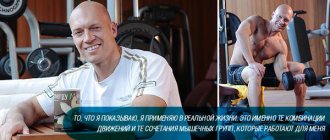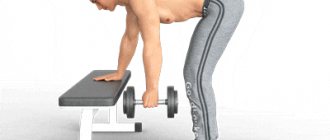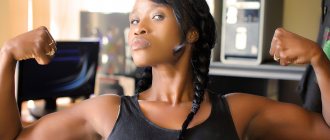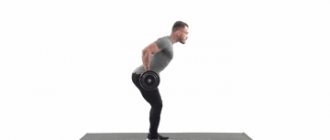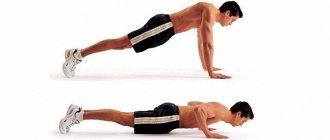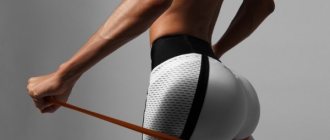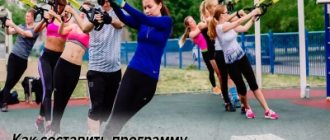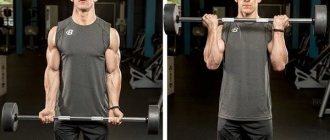On the same day or on different days?
It turns out that many back exercises involve the biceps, but not vice versa! That is, by pumping your back, you can also pump your biceps, but when working the biceps muscle, you will not use the back muscles.
There are some back exercises that do not involve the biceps muscle at all or only slightly affect it. This is, for example: bent over dumbbell raises (loads the trapezius and shoulders), hyperextension, etc.
Pull-ups, bent-over dumbbell rows, block rows, barbell rows and any other exercises where you lift weights by bending your arms involve the biceps.
Therefore, if you decide to pump them in one day, start with the heavier one - from the back.
It is difficult to talk about the correctness of this approach in training the back and biceps. This is practiced everywhere. And everyone chooses for himself whether such a scheme is acceptable specifically for him.
You need to focus on the following: if you started working on your biceps and feel that you don’t have enough strength to complete the exercise, it’s too early for you to train your back and biceps on the same day.
If you choose a multi-day training regimen, then the muscles of the back and arms have time to rest. As a result of this, you can fully pump your biceps to full strength.
It is better for beginners to adhere to just this scheme, since when training with the back on the same day, the effectiveness of biceps training decreases. The muscles already get tired during back exercises. And there is no longer enough strength to fully work with your hands.
You can cheat and do the biceps lift first, and then pump up your back. But this contradicts the training policy in the gym, which says: first train large muscles, then small ones. That is why, at the beginning of any training, basic exercises are done, and then some isolated ones.
Therefore, at the beginning of the training, the legs and back are pumped, and then everything else. This makes sense from the point of view of energy consumption - a large muscle consumes more energy than a small one. Therefore, it is not recommended to pump your biceps in front of your back.
So what should you do? What to do, pump these muscle groups on one day or on different days? The answer is - if you have enough strength for one day's work - swing like that. If not, divide it into different days. Many people find it more convenient to train their back and biceps on different days.
As a result, we can say:
- When it comes to fat-burning training, it makes no difference whether you combine or separate the training of these muscle groups. Since you are not trying to increase strength and muscle size.
- In the case of bodybuilding, it is permissible to work in a one-day mode.
- In strength training, it is more effective to give the muscles normal rest.
Exercises for the latissimus dorsi muscles
Let us go over the basic and most powerful exercises for our latissimus dorsi muscles.
The first exercise will rightfully be pull-ups.
Pull-ups
This is the coolest exercise for developing the latissimus dorsi muscles, which many people don’t do for various reasons, but in vain.
This is an extremely physiological exercise for you and me, because... our ancestors were forced to spend a lot of time in the trees. However, if you believe that man appeared on Earth as a result of other circumstances, then I cannot convince you of this.
But I think it’s pointless to argue that the crossbar appeared on Earth much earlier than deadlifts and dumbbells, this is already clear)
Pull-ups develop the width of the “wings”, and horizontal rows (any) develop thickness (the edge of the lats thickens).
Learn to turn off the biceps from work when doing pull-ups (due to the “muscle feeling”) so that the biceps does not steal the load from the latissimus muscles. At each point in the pull-up movement, think about your lats and how they contract at each point in the movement.
If you have no problems with this, and you definitely “bomb” your lats in pull-ups, then it’s time to decide on the following points:
Grip:
- Narrow;
- Average;
- Wide;
Brush position:
- Directly;
- Toward yourself (reverse grip);
- Parallel;
Load:
- Your weight;
- With weights;
- Standing on a support (in the simulator or from the hands of a partner);
The choice, as we see, is very healthy. So, in general terms:
The wider the grip = more lat work + less work.
The narrower the grip = more biceps work (less back) + more work.
Wide or narrow grip?
The narrower the grip, the greater the amplitude of movement created, but the biceps will work harder. If you have learned to feel your lats well and turn off your biceps, then you can do pull-ups with a narrow grip, because the work in this case will be stronger (greater amplitude of movement). But if you feel that your arms are getting clogged during pull-ups, then take them wider. Also, try using an "open grip" (this is when your thumb is not wrapped around the bar), this will reduce the stress on your forearms.
In general, try to do pull-ups with a “medium grip”, because... In this case, it will be easier to feel the lats and turn off the biceps.
What is the position of the hands?
The more the hand is turned (supinated towards itself, as with a reverse grip), the less the load on the forearms, but we won’t be able to take a wide reverse grip because of our anatomy, and the narrower we take it, the more the biceps works. The solution is a parallel grip (on a horizontal ladder, for example). This way the hand will be supinated and you can take it wider.
Pull up to your chest or behind your head?
If you pull yourself up by your head, you use fewer back muscles than when you pull yourself up to your chest. But the advantage of doing pull-ups is that this way you engage more of the upper back muscles. In short, pull-ups to the chest involve more muscles in the work (more basic exercise), and behind the head emphasizes the upper back muscles (more isolating). At the initial stage, I would not bother with this issue and would pull myself up to my chest.
Should I add weights or not?
In order for muscles to grow, a progression of loads is needed. If the load does not increase, then there is no point in the muscles increasing, because... this is a very energy-intensive process. There are a couple of clarifications. First, you should add weights when your technique is perfect (you feel the lats perfectly). And secondly, you should work in the range of 6-12 repetitions (approximately), so when you can already do pull-ups with perfect form more than 12-15 times, then it’s worth increasing the weight.
Exercise vertical block row
These are, one might say, “lightweight pull-ups.” Everything I said about grips, hand position, load, etc. all this applies to this exercise. For beginners, this exercise is BETTER than pull-ups, because, as a rule, they cannot yet do pull-ups properly. Moreover, with this exercise it is easier to control the load and contraction of the lats. If you are an advanced lifter, you should definitely include this exercise in your arsenal AFTER your pull-ups to further fatigue your lats.
Bent-over barbell row
This exercise belongs to the “horizontal rows”, i.e. builds the latissimus dorsi muscles in thickness. The main thing in absolutely all deadlifts is a straight back! This will save you from injury, and will also allow you to work your latissimus muscles more specifically.
Almost everything that I said in pull-ups about the grip is also true for bent-over barbell rows, but there is one BUT.
If you take a reverse grip on the barbell and perform rows, you will notice that your elbows do not spread out to the sides, but move in parallel, accordingly, the latissimus muscles can be felt better, but the biceps also work stronger. When we grab with a direct grip, the elbows spread out more (especially with a narrow grip), so the trapezius and rear delta are more involved in the work. So it goes.
Now about the tilt:
- More tilt = more back work;
- Less tilt = more trapezius work;
In my opinion, and in my experience, it is best to grab with a Medium overhand grip and approximately 20-30 degrees from horizontal (i.e. almost parallel to the floor). The back must be straight, and the bar moves parallel to the bent hips.
T-bar row
Almost the same as bent over rows. But here a deeper study of the inner part of the back (between the shoulder blades) is given. In fact, this is simply a more convenient version of the bent-over barbell row.
There are a lot of different T-bar pulls. The main ones are in a standing and lying position. When you perform the exercise while standing, it is practically the same as the bent-over row of a barbell, it’s just more convenient, but lying down, a number of inconveniences already begin here, because To properly contract the lats, you need to bend in the back (in the scapular region), and this is difficult to do while lying down.
In general, if you have a standing T-bar, then you can choose it as an alternative to bent-over barbell rows, but if you have a bench press, then it’s better not to do it, especially at the initial stage.
Bent-over dumbbell row exercise
The technique for performing the exercise should be as follows:
- Lean forward and take the dumbbell in your right hand, lean on the bench with your left hand and left leg bent at the knee, and put your right leg back.
- The movement of the hand should be strictly vertical, and the movement should be parallel to the body (the hand does not move to the side).
- The body does not change position! The back is always straight (bent in the opposite direction!).
There is a wider range of motion here than with the bent-over barbell row, because... the bar does not interfere with raising the elbow above the lower back. More work and muscle contraction. Support with your knee and hand allows you to unload the spine. And also, because The exercise is performed with one hand, then you can feel your muscles better.
Lever pull in Hummer
Hammer-type exercise machines appeared not so long ago, but have successfully entered all modern fitness centers. This is a great exercise and variation of the horizontal row. The exercise is similar to a one-arm dumbbell row, but because your torso is vertical, it is easier to perform and the weight can be lifted heavier.
Exercise horizontal block row
It is believed that this exercise specifically affects the lower latissimus muscles, but this is very conditional, because The emphasis of the load will depend on where you pull the handle.
- Pull towards the navel = works the bottom of the lats;
- Pull towards the chest = works the top of the lats;
But it will be easiest to pull towards the navel, hence this statement.
A few more tips on the technique of performing this exercise. I very often see how exactly this exercise is performed and I don’t even understand how!
My version of this is: Sit with your back straight (slightly arched back at the shoulder blades), lean forward to stretch your lats. Now pull the handle towards you while simultaneously returning your body to a vertical position.
Very important!!! You should pull with your lats, not with your body! Those. There is no need to pull the handle towards you with your whole body, and then, by inertia, bring it towards you with your hands. The movement begins by pulling the shoulders back, then pulling the handle toward you, feeling the lats at each point, and returning the body to a vertical position.
Back and biceps exercises in one day
If you decide to train both muscle groups on the same day, here is a list of exercises that you can use.
Back
First we do exercises for the back.
Wide-grip pull-ups or bent-over rows
On the day of training the back and biceps, it is not advisable to do a lot of pull-ups with a narrow grip, since the emphasis of the load falls on the arms.
Since you are pumping your back, let’s pump it up, that is, pull yourself up with a wide grip behind your head. You can divide the exercise into 2 parts: 2 approaches you pull yourself up by your head, and 2 approaches you pull the horizontal bar to your chest. In any case, remember that you still have to pump your biceps.
The basic exercise for the back is the bent-over barbell row. If you decide to do it on biceps day, put it first and skip the pull-ups.
Other rows, fly-ups, hyperextensions
Instead of a horizontal bar, you can work in a block simulator using the same scheme.
- Next comes either the T-bar row, or the row in the simulator, or the lower block row to the lower back. Do this exercise in 3 sets of 8-10 times.
- Then take dumbbells and do bent-over raises on the upper back and back of the deltoids. Or raising your arms in a block simulator.
- And don’t forget to do hyperextension to keep your lower back toned. It should be done twice a week - on back day and before deadlifts as a warm-up for the lower back.
This is an approximate scheme; each person individually needs to select a training program, check it, and constantly adjust it. Therefore, it is still better to order it from an experienced trainer rather than experimenting yourself.
Biceps
Next, we will have hands.
Barbell Curl
For biceps, the basic exercise is the barbell curl. If you've already done an upper back workout, do 3 sets of this exercise with enough weight to complete 8-10 reps.
It is advisable to lean your back against a wall or a power frame. Secure your elbows to the body and work without throwing the barbell upward due to vibrations of the torso. It's the hands that have to do the work.
Scott's bench
This is an alternative to the concentrated biceps curl, but this exercise is slightly different from the curl. Therefore, you can perform either this or the version with dumbbells.
Choose the weight carefully: the exercise is easy during the first repetitions, but then it makes you sweat. If you keep your arms straight, this exercise will be easier. But the whole point is the maximum amplitude of muscle contraction. Therefore, on the Scott bench you need to work at full amplitude. It is recommended to work in the upper zone of amplitude after stretching the biceps with light weights three times a week (in the absence of acute pain).
Dumbbell Curl
Instead of a Scott bench, you can use dumbbells on an incline bench.
Alternatively, you can sit on a Scott bench, but with your back to the elbow pad. Lower yourself down a little so that your arms hang back a little under the force of gravity. From this position it is convenient to do biceps curls in different styles - with a parallel grip and in the form of a “hammer”.
Focus on the exercise, you must understand and feel what you are doing, and not just mechanically practice the movements. Such conscious control will help to clearly maintain the exercise technique.
When lifting heavy weights, this focus makes it difficult to break records. In our case, it is necessary for better quality work.
Exercises
When choosing ways to pump up your biceps and back muscles, fitness trainers traditionally give preference to time-tested basic exercises.
If they are performed regularly with full adherence to the technique, visible results will be noticeable within 3-4 weeks.
With dumbbells and other equipment
Bent-over one-arm dumbbell row
Starting position (IP): lean on the bench with the knee of your left leg and left hand, evenly distributing the weight. The spine should be straightened as much as possible, the head is a continuation of the body, the gaze is directed downward, the right hand holds a dumbbell of the working weight. Take a deep breath and begin the exercise. As you exhale, pull the dumbbell up, bending your arm at the elbow joint
It is important to ensure that only the back muscles are involved, and not the arms. After fixing the position for 2-3 seconds, slowly return to the original position
Deadlift on straight legs
IP: take a vertical position, your back is straight, your shoulders are straightened as much as possible, your stomach is pulled in, your hands hold the barbell with weights that together form the working weight, your gaze is directed in front of you. As you exhale, bend forward without bending your knees. The barbell should be as close to the floor as possible at this moment. Without pausing, slowly return to IP, controlling your breathing.
Standing barbell curl
IP: stand up straight, take the barbell in your hands, grasping it as widely as possible, your back is straight, your chin is slightly raised. As you exhale, bend your arms at the elbow joint, bringing your hands and the barbell as close to your chest as possible. After holding this position for 3 seconds, straighten your arms, returning from the IP
It is important to remember that when returning your hands to their original position, you must slowly take a deep breath.
Lifting dumbbells while sitting on an incline bench
IP: sit in a sitting position on an inclined bench, pressing your back tightly to the surface, feet resting on the floor, hands holding dumbbells and lowered along the body with palms facing you, elbows pressed to the body. As you exhale, bend your arms one by one without changing the position of your body.
With its own weight
Without the opportunity to visit the gym or exercise at home using specialized equipment, the athlete can include bodyweight exercises in the training program to pump up the back and biceps.
Pull-up on the horizontal bar with a reverse grip
Starting position (IP): clasp the horizontal bar with your fingers so that the clenched palm is directed towards you, lift your legs off the floor. In parallel with exhalation, it is necessary to pull the chin towards the horizontal bar bar, due to the work of the arm muscles, avoiding various movements of the lower body. Maintaining the resulting position for 2 seconds, inhale and slowly straighten your arms, lowering yourself down into the IP position.
IP: take a similar position as before traditional pull-ups on the horizontal bar, avoiding the formation of deflections in the body. As you exhale, you need to pull yourself up to the horizontal bar bar and, while maintaining your height, seem to push yourself to the side along the horizontal axis. At the same time, you must also raise your legs, trying to fully position your body horizontally. It is necessary to alternately move away from the horizontal bar and approach it, without changing the height and position of the body, a specified number of times. At the end of the exercise, slowly straighten your arms and return to the IP position.
IP: take a horizontal position, resting your forearms and feet on the floor, lift your body from the surface, muscles are tense as much as possible, your stomach is pulled in, your head is a continuation of your torso, your gaze is directed downward
It is important to avoid the formation of deflections during the exercise. As you exhale, you need to pull your left leg towards your chest, bending it at the knee.
Without staying in this position for a long time, straighten the limb. Repeat similar actions with the other leg.
Cable pull-ups
IP: grab a firmly fixed cable with your hands, your feet rest on a hard surface (floor or ground), your body is tilted at approximately 45 degrees and represents one straight line. As you exhale, pull the body towards the hands, while avoiding the formation of deflections. Having fixed this position for 5 seconds, slowly straighten your arms, returning to the original position. Repeat the described steps as many times as necessary.
Biceps exercises on a separate day
When your biceps are not tired from back exercises, you can do more arm exercises.
For example:
- Curling arms with a barbell.
- Hammer.
- Concentrated biceps curl.
Instead of a hammer, you should periodically do dumbbell curls. For example, one week you do a hammer, and the next week you do a regular curl. Some people say that turning your palm during dumbbell curls is harmful. But many athletes do it and achieve excellent results. It's up to you what to choose.
Since your biceps are not yet exhausted, you can do all the exercises in 4 sets. Work to failure in everything except fat loss. In the latter option, your task is to do many repetitions in a short time.
Hammer and dumbbell curls can be done with both hands at the same time or alternately. In the latter case, you cannot raise the second hand until the first one stops. There are explanations for this, just remember this nuance.
Exercises to train the biceps muscles
Standing biceps curl
video - standing biceps curl
- a wide grip (wider than the shoulders) puts more load on the outer (long) head of the biceps;
- a narrow grip (narrower than the shoulders) puts more load on the inner (short) head of the biceps;
- when lifting the barbell for biceps while standing, you do not need to swing and help yourself with your body - this reduces the effectiveness of the exercise, transferring part of the load to the back and chest;
- do not throw the barbell when moving down, lower it under control;
- do not bend your wrists - this can lead to injury;
- keep your arms (shoulders and elbows) pressed to your body, movement is carried out at the elbow joint.
Standing bicep curls can be performed with a curved EZ barbell to reduce stress on the wrists.
Dumbbell curls with supination
video – lifting dumbbells for biceps with supination
- the exercise is performed with supination - rotating the hands outward while lifting dumbbells, which engages small muscles and increases efficiency;
- Elbows should be fixed (do not spread them to the sides), shoulders should be perpendicular to the floor;
- when lifting dumbbells for biceps, you do not need to swing and help yourself with your torso - this reduces the effectiveness of the exercise, transferring part of the load to the back and chest;
- You can do the exercise on a bench with an incline (about 60 degrees), this will increase the range of motion.
Lifting the barbell on a Scott bench
video - lifting the barbell on a Scott bench
The exercise, lifting the barbell on a Scott bench, specifically works the long (outer) and short (inner) heads of the biceps. To reduce stress on your wrists, use an EZ curved barbell.
- the armpits rest against the corner of the bench;
- the shoulders lie entirely on the bench;
- grip with hands from below, shoulder-width apart (a wider grip will put more load on the inner head of the biceps);
- arm curls with a barbell are performed without jerking, under control;
- do not help yourself with your body and do not lift your elbows from the pillow;
- do not overextend your elbows at the lowest point.
Exercises for the trapezius muscle of the back
I have already discussed this issue in great detail in an article on how to pump up a trapezoid. But repetition, as they say, is the mother of learning.
Shrug exercise with barbell
The moment of “SHRUGGING” THE SHOULDERS is important, so it doesn’t matter whether it’s a barbell, a Smith machine or a canister of water, the main thing is to perform this movement.
Shrugs from English. shrug - “shaking.” This exercise really looks like a shrug. We must move the shoulder blades vertically upward. This is the main function of the trapezius muscle.
So, the more you lean forward, the more load will go from above to its middle parts (between the shoulder blades). Beginners do not need this exercise at all, because... So far, at the beginning, there is no point in worrying about relatively small muscles.
It's better to focus on your lats, chest, for example, and legs. The most important thing when performing shrugs is that you should not rotate your shoulders!!! The movement must be strictly up and down.
Our shoulders are poorly adapted to rotational movements, so we can get injured very easily. And in general there is no point in rotation, because... This does not in any way speed up the growth of the trapezius. Hold the dumbbells in your hands or a barbell in front of you and perform the movements as if you were shrugging your shoulders, moving them straight up and down, so you can feel your trapezius contracting.
Questions related to how to pump up your back
At this point, the topic of back training is almost covered, but I feel that some questions may still arise. I decided to collect all the questions that I was once asked about back training and highlight them below:
“If after I trained my back over the next few days it doesn’t hurt, does it mean that I didn’t receive the necessary microtraumas for growth?”
Indeed, pain in the next days in a previously trained muscle group indicates microtraumas that will lead to growth, but this is not a necessary sign of growth! The better trained you are, the less pain you will feel. The sign of growth is an increase in load! If the load is constantly growing, then you are growing.
“Should I stretch my back extra between sets?”
Yes. This works great because... In this way, the muscular fascia of the back muscles is additionally stretched, there is better blood supply, and, accordingly, better growth.
“Which exercise for developing the back do you consider the best, if you can only do one exercise on the back?”
Of course, pull-ups. They perfectly grow the latissimus muscles in width.
“Which exercise is better to choose to increase the thickness of the lats: bent-over barbell row or bent-over dumbbell row?”
It’s better, in my opinion, to do bent-over barbell rows, because... It’s easier to progress the load there.
“If you have to combine your back with another muscle group, which one?”
With deltas. Or with biceps (not with arms). This is perhaps the most popular combination.
“What should I do if my wrists hurt a lot while doing pull-ups and vertical block rows?”
Experiment with grips, reverse or straight. Also, a parallel grip easily solves this problem. Well, the traction (straps) should help a lot.
“Do I need to use a belt for bent-over barbell and dumbbell rows?”
I use the belt in almost all exercises where I feel tension in the abdominal cavity (except for abdominal training, of course). This allows you to avoid intervertebral hernia and an increase in waistline. Why do you need a big belly?
